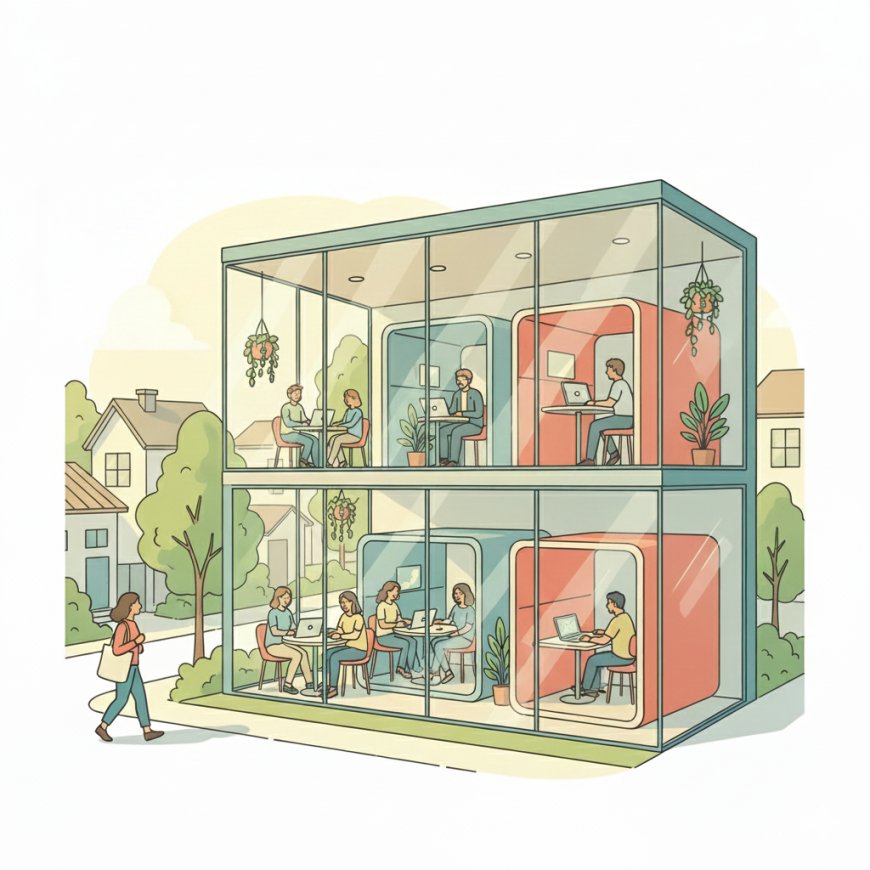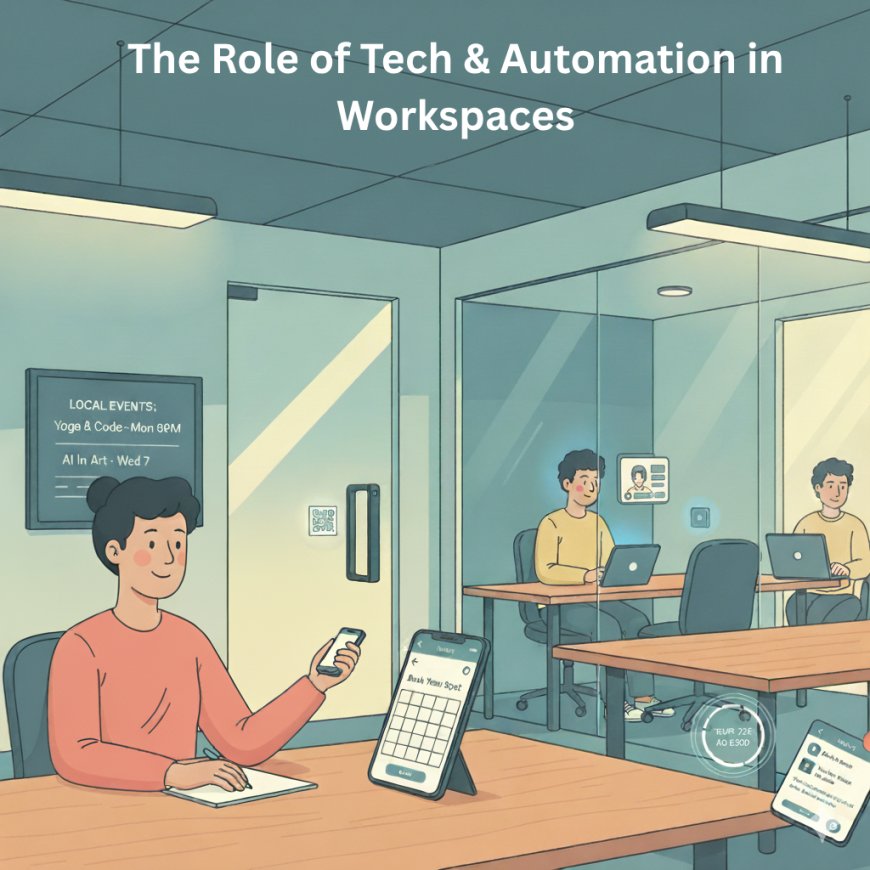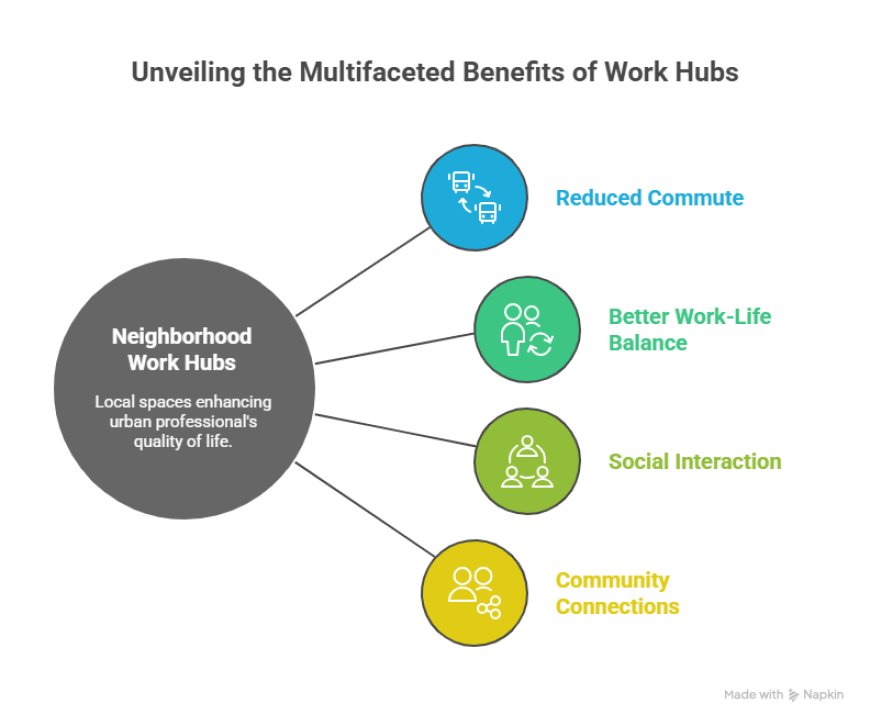The Evolution of Workspaces in a Hybrid World
Discover how Co-working 3.0 and neighborhood work hubs are transforming the future of work in India. Learn why hybrid teams prefer flexible, near-home workspaces and how this shift is reshaping real estate, workplace culture, and city planning.

For decades, the idea of “work” was defined by a physical location — usually a centralized corporate headquarters located in a major commercial district. Employees traveled daily, sometimes hours each way, to be physically present. The office wasn’t just a place to work; it symbolized professional identity, teamwork, and company culture.
But in the last few years, that definition has changed dramatically.
The pandemic pushed millions of people into remote work, forcing organizations to adopt digital workflows almost overnight. What started as a temporary solution became a long-term shift. Employees realized they could work effectively from home — and also rediscovered the value of personal time saved from long commutes.
This gave rise to hybrid work, where people split time between home and shared spaces. And in this new model, workers began to prioritize:
- Shorter or zero commute times
- Work-life flexibility
- Mental and physical well-being
- The ability to choose their best environment for productivity
As a result, the role of the office itself is being redefined.
Co-working spaces, once considered the domain of freelancers and early-stage startups, have now become a mainstream enterprise solution. Companies of all sizes — from global firms to fast-scaling startups — are adopting flexible workspace strategies that fit the rhythm of modern work.
The office is no longer about where you must be.
It is about where it makes the most sense to meet, collaborate, and create.
What Is Co-Working 3.0?
Co-working has evolved in phases — each reflecting how work culture has shifted.
|
Stage |
Description |
Primary Users |
Key Value |
|
Co-working 1.0 |
Shared spaces with open seating |
Freelancers, solopreneurs, early startups |
Community + low-cost workspace |
|
Co-working 2.0 |
Large corporates leasing dedicated floors & private suites |
Enterprise teams, scale-ups |
Flexible leasing + managed office experience |
|
Co-working 3.0 |
Distributed micro work hubs, located near where people live |
Hybrid teams across industries |
Convenience + flexibility + collaboration on-demand |
Co-working 3.0 reflects the reality that:
- Work can happen anywhere (home, café, remote city, vacation spot).
- But collaboration still needs a place — for meetings, brainstorming, culture building, and mentoring.
Key characteristics of Co-working 3.0:
- Decentralized micro hubs instead of single large city-center offices
- Located close to residential neighborhoods, not just business districts
- Flexible memberships — individual days, team passes, usage-based billing
- Designed for hybrid work rhythms — teams meet only when needed, not daily
- More private spaces & focus zones, fewer open-plan distractions
- Integrated tech-enabled booking and access systems
It’s not just workspace anymore — it’s a local work ecosystem.
The underlying insight is powerful:
Work happens anywhere — but collaboration needs a place.
And that place is now becoming near home, not in distant business districts.
This shift is influencing corporate real estate strategy, employee expectations, urban planning, and the very definition of what it means to “go to work.”
The Rise of Neighborhood Work Hubs
As hybrid work became the norm, a crucial realization emerged:
Employees don’t necessarily want to work from home — they want to work near home.
The home can be distracting. The corporate HQ can be too far. Cafés are inconsistent.
The middle ground? Neighborhood work hubs.
These are small, professionally managed co-working spaces located within residential or mixed-use areas — allowing people to get to work in 5–20 minutes, often by walking or a short commute.
What these micro-hubs offer:
- High-speed WiFi and power backup
- Private cabins and soundproof pods for calls
- Meeting rooms with screens & collaboration tools
- Wellness rooms, lounges, and quiet zones
- On-demand booking apps & monthly flexible passes
The experience is professional, not makeshift.
Unlike cafés or dining spaces:
- No noise
- No seating uncertainty
- No pressure to buy something every 45 minutes
Unlike working fully from home:
- Clear boundaries between work and personal environment
- Higher focus and productivity
- Smooth collaboration when teammates join
A Community Layer is Emerging
Local hubs often host:
- Founder meetups
- Learning circles
- Mental health sessions
- Skill workshops
- Neighborhood business networking
Co-working is becoming a part of everyday neighborhood life, much like gyms and cafés once did.
Work is no longer an isolated commute-based activity — it is integrating into the local urban fabric.
Why Companies Are Adopting This Model
This shift isn’t just employee-led — companies are strategically adopting flexible, neighborhood-centric workspace models because it makes business sense.
Key Advantages for Organizations:
1. Lower Real Estate Costs
o Traditional HQ leases lock companies into long-term, expensive commitments.
o Distributed hubs + flexible co-working passes allow pay-for-usage instead of paying for unused space.
2. Scales With Growth — Without Friction
o Teams expand or shrink?
No need for renovations, relocations, or long notice periods.
o Workspaces adjust on demand.
3. Access to Talent Beyond Big Cities
Instead of limiting hiring to people in Mumbai, Bengaluru, Delhi NCR, etc.,
companies can support talent in:
o Tier-2 & Tier-3 cities
o Semi-urban regions
o Distributed remote teams
Hiring becomes location-agnostic.
4. Happier, More Energized Employees
Shorter commutes → better mental health & more rest
Better work-life balance → more sustainable productivity
Familiar local environment → lower burnout and turnover
5. Supports the Rhythm of Hybrid Collaboration
Teams don’t need to meet every day — just when necessary:
o Weekly stand-ups
o Monthly planning sessions
o Occasional collaboration sprints
Space becomes intentional — not mandatory.
In essence:
Neighborhood work hubs enable companies to reduce costs, expand talent pools, and improve employee well-being — while maintaining collaboration and culture.
This is why Co-working 3.0 is not a temporary trend.
It is the new operating model of work.
How Commercial Real Estate Is Evolving
The shift to hybrid work hasn’t just changed employee routines — it’s reshaping the entire commercial real estate model.
For decades, companies invested heavily in large corporate towers, often located in high-density business districts. These spaces symbolized scale, stability, and centralization.
But today, the value equation has changed.
What companies now need:
- Flexibility on demand
- Regional presence without full infrastructure investment
- Workspaces that match how teams actually collaborate
This means demand is moving away from giant headquarters and into distributed work hubs across the city — and often, across the country.
Key Real Estate Shifts:
|
Old Model (Property-Led) |
New Model (Service-Led) |
|
Long-term leases |
Flexible short-term passes & memberships |
|
Static floor plans |
Modular spaces that reconfigure easily |
|
One central office |
Multiple small satellite hubs |
|
Location = status |
Accessibility = productivity |
Older office buildings — especially those affected by low post-pandemic occupancy — are now being repurposed into co-working centers or managed office solutions.
Meanwhile:
- Tier-2 & Tier-3 cities (Surat, Indore, Kochi, Coimbatore, Jaipur, Lucknow) are seeing new investments, as distributed teams and remote hiring rise.
- Growth is no longer metro-centric.
And perhaps the biggest shift:
Real estate is becoming a service.
Not just space to rent, but a full workplace experience — managed, furnished, and enabled with tech infrastructure.
Design Trends in Co-Working 3.0 Spaces
Co-working is no longer about bean bags, neon signs, or “startup energy.”
The aesthetic of Co-working 3.0 is calm, intentional, and productivity-first.
The focus is shifting from looking cool → to helping people work well.
Design Priorities in Modern Neighborhood Work Hubs:
• Sound-Proof Work Pods & Private Rooms
Deep work needs silence. Phone calls need privacy.
Noise control has become a core UX feature.
• Natural Light & Biophilic Design
Indoor plants, sunlit seating, fresher air flow →
proven to reduce stress and improve focus.
• On-Demand Meeting Rooms
Bookable rooms via app → no awkward competing for space.
• Café Lounge Areas
Designed not for loud chatter, but for relaxed, informal collaboration.
Think: soft seating, warm lighting, quiet conversation corners.
• Quiet Zones
Head-down zones where no calls or discussions are allowed —
especially important for remote roles requiring deep thinking.
• Wellness & Ergonomics
Standing desks, ergonomic chairs, air-quality measures.
People spend 8+ hours here — comfort is no longer optional.
• Family-Friendly Features (Emerging Trend)
Some neighborhood hubs are introducing:
- Parent rooms
- Child-friendly breakout spaces
- Stroller parking spaces
This acknowledges something fundamental:
Workplaces are becoming extensions of daily life, not separate from it.
This evolution signals a maturity in how we understand productivity:
We’re moving from spaces that look impressive → to spaces that feel supportive.
The Role of Tech & Automation
Co-working 3.0 isn’t just a physical space shift — technology is the backbone that makes these new work models smooth, flexible, and scalable.
To function like a seamless extension of your workflow, neighborhood work hubs are increasingly tech-enabled environments.

How Tech Powers Modern Workspaces
• App-Based Desk & Meeting Room Booking
No more guessing or walking around searching for a free seat.
Employees simply open an app, pick a desk or private pod, and reserve in seconds.
• Digital Access Controls (Smart Entry)
Swipe cards and manual check-ins are fading out.
Instead: QR access, biometric entry, and mobile app verification.
Security stays tight, but entry is frictionless.
• Smart Climate & Lighting Systems
Lighting adjusts by time of day.
Air conditioning optimizes energy use based on occupancy.
Ergonomics and comfort aren’t just design elements — they’re AI-managed experience layers.
• Virtual Office & Business Address Integration
Remote-first companies can register professional addresses and handle mail without maintaining physical headquarters.
• Community & Events Engagement Apps
From:
- Networking events
- Skill-sharing workshops
- Wellness sessions
- Founder meetups
Members get notified automatically, fostering local professional communities — not just shared desks.
In Co-working 3.0, the workspace is as “smart” as the work being done inside it.
Technology transforms convenience into everyday productivity.
The Benefits for Employees
The real transformation is human, not architectural.
Neighborhood work hubs solve one of the biggest quality-of-life drains for urban professionals:
The daily commute.
Instead of spending 2–4 hours stuck in traffic or trains, employees now work closer to home — without sacrificing professional workspace quality.

What Employees Gain:
• Reduced Commute → More Personal Time
More sleep. More family time. More rest.
Energy goes into work, not travel.
• Better Work-Life Balance
Flexibility means employees manage:
- errands
- parenting needs
- workouts
- personal routines
without disrupting work.
• Social Interaction Without Corporate Overload
You meet peers, collaborators, founders —
but on your terms.
No forced office cultural pressure.
• Neighborhood-Based Community Connections
This is one of the most underrated benefits.
Local work hubs often lead to:
- new friendships
- shared hobbies
- mentorship networks
- local business support (cafes, gyms, studios grow too)
Work becomes something that integrates into life, not something that interrupts it.
Co-working 3.0 is restoring balance — allowing people to be productive and
present in their daily lives.
Challenges to Address
The transition to Co-working 3.0 is promising, but it also comes with practical challenges that businesses need to navigate thoughtfully.
• Standardizing Workplace Quality Across Locations
When companies allow employees to work out of multiple neighborhood hubs, the experience cannot vary drastically.
Whether someone in Bangalore works from Koramangala or Whitefield, the basics should feel consistent:
- Reliable internet
- Comfortable seating
- Noise control
- Meeting room availability
This requires operators to maintain uniform service benchmarks, not just attractive front-end branding.
• Clear Hybrid Work Policies Are Needed
Without clarity, hybrid can easily become chaotic.
Companies need to define:
- Which days are in-person collaboration days
- Expectations around availability
- How performance is measured
The most successful hybrid teams design their rhythm intentionally, instead of leaving it to chance.
• Data Security & Privacy Considerations
Distributed work increases exposure risk: shared WiFi networks, open desk layouts, multiple access points.
Work hubs and organizations must implement:
- VPN access
- Zero-trust security frameworks
- Smart access controls
Security must evolve along with workplace flexibility.
• Maintaining Team Culture Across Distributed Workspaces
When teams aren’t sitting together daily, culture cannot rely on proximity.
It must be built through:
- Regular meetups
- Rituals (weekly syncs, Friday shared lunches, monthly team days)
- Shared digital collaboration norms
Culture becomes something you design, not something that “just happens.”
These challenges are real, but they are solvable.
The organizations that embrace hybrid with intention will gain agility, happier teams, and wider hiring reach.
The Future: The “15-Minute Work City”
Urban work culture is shifting toward a new design principle:
Life and work should exist within 15 minutes of each other.
This is known as the “15-minute city” idea — where everything you need is nearby:
- Workspaces
- Coffee shops
- Gyms
- Groceries
- Daycare
- Parks
Under Co-working 3.0, this evolves into the:
15-Minute Work City.
Instead of employees traveling to city centers, work flows toward where people live.
How Cities Will Transform:
• Office districts become mixed-use neighborhoods.
Skyscraper-centric business zones become less relevant.
Local hubs gain importance.
• Workplaces integrate into everyday community life.
Your office could be:
- Above your favorite café,
- Next to a grocery store,
- Or across from your kids’ school.
• “Commute” becomes a walk, cycle, or short scooter ride — not a 2-hour endurance test.
This shift supports:
- Sustainability
- Mental well-being
- Family life
- Local economies
and a healthier relationship between work and life.
The future workspace is not one big office — it’s a network of small, human-centered spaces designed around real life.
Conclusion
Co-working 3.0 is more than a new type of office space — it represents a fundamental shift in how work fits into life.
Instead of forcing people to commute long distances to a centralized headquarters, work is now becoming local, flexible, and human-centered.
Hybrid teams are no longer an exception; they are shaping how companies make decisions about:
- Office budgets
- Real estate footprints
- Team collaboration rhythms
- Hiring talent across cities and regions
This model allows organizations to access wider talent pools, while also helping employees enjoy better work-life balance. Cities will adapt too — workplace design will blend into neighborhoods, and local communities will benefit from increased activity, services, and economic participation.
The office is no longer the center of work — people are.
And the future of work will be built around where life already happens.
What's Your Reaction?
 Like
0
Like
0
 Dislike
0
Dislike
0
 Love
0
Love
0
 Funny
0
Funny
0
 Angry
0
Angry
0
 Sad
0
Sad
0
 Wow
0
Wow
0
























































































































































































